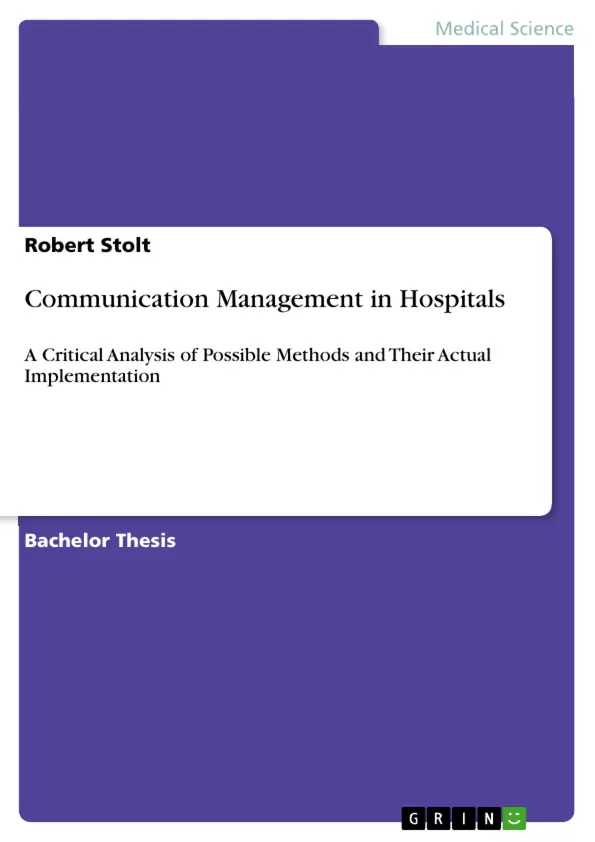In recent years, the German health care sector underwent considerable structural changes. Nevertheless, medical facilities increasingly recognise that their resources are limited and that they are subject to mechanisms of other markets, meaning that they need to ensure the own position in the health care market more than ever (Schreyögg, 2000, p. 185). Increased competition between hospitals, scarce resources, and amendments of legislation are forcing every provider of medical services to consider a sustained and efficient structure of the provision of their services over and above a strong customer orientation. With several reforms coming from the government, which were supposed to retain an eminent level of public health care and at the same time putting a halt on the consistently rising health care costs, the hospital was now heavily reliant on the number of patients treated. Thus, hospitals were faced with the challenge of retaining or gaining more patients, while concurrently having an unchanged or lower budget, which meant that the role of the hospital changed from being a mere renderer of medical services to having the function of an economic actor. Concretely, this implied for hospitals adopting a strategic concept that is aligned to the market and to the heterogeneous target groups of this market. Moreover, patients are nowadays not only driven in their demand by the quality of the medical treatment, but by a function of several different factors, which include among others the communication of a positive image through advertising and public relations. Nevertheless, business-like reasoning of the economist on the one hand and traditional Aesculapius professional perception of the physician on the other hand seem to be incompatible with each other, especially when having to make cost-benefit considerations for a treatment or in terms of hospital advertising. Frequently, ethical concerns stand in the way. However, it is inevitable that with the transition from a state-controlled to an autonomous health-care sector in a free-market economy, these concerns are put aside in the long-term, the more so as rising privatisations require economic thinking in hospital management. In every corporate process, communication management is a decisive factor and it should be embraced whenever implementing new strategies or informing the internal or external public (Ströh & Jaatinen, 2001, pp. 143-168).
Inhaltsverzeichnis (Table of Contents)
- Hospitals in the German Health Care Market
- Structure of the Hospital Environment in Germany
- Trends and Developments in the Hospital Environment
- Communication Management and the Hospital Sector
- Introduction
- Problem Formulation and Objectives
- Course of the Investigation
- Principles of Communication Management
- The Concept of Communication
- Communication Management and Integrated Communications
- Aims of Communication Management
- Methods of Communication Management
- Aspects and Limitations of Communication Management in German Hospitals
- The Communication Management Process in Hospitals
- Problem Analysis and Target Definition
- Target Groups
- Criteria for Target Group Definition
- Analysis of Hospital Target Groups
- Strategy Formulation and Communication Instruments
- Budgeting and Monitoring
- Forms of Communication Management and Their Application in Hospitals
- Corporate Identity
- Relevance of Corporate Identity for Hospitals
- The Corporate Identity Mix for Hospitals
- Corporate Identity Strategy in Hospitals
- Internal Communication Management
- Employee Communication
- Personnel Management and Development
- External Communication Management
- Aims of External Hospital Communication
- Hospital Advertising
- Direct Communication
- Multimedia Communication
- Communication with Referring Physicians
- Communication with Health Insurance companies
- Public Relations
- The role and significance of communication in the hospital environment
- The complexities of communication management within hospitals
- The importance of target group analysis and segmentation in hospital communication
- The application of various communication instruments and strategies in hospitals
- The challenges and limitations of effective communication management in the German hospital sector
Zielsetzung und Themenschwerpunkte (Objectives and Key Themes)
This thesis examines the challenges and opportunities of communication management in the German hospital sector. It aims to critically analyze various communication methods and their implementation in practice.Zusammenfassung der Kapitel (Chapter Summaries)
The first chapter introduces the context of the German healthcare market, outlining the structure and trends within the hospital environment. Chapter two explores the fundamental principles of communication management, including its concepts, aims, and methods. Chapter three delves into the specific application of communication management in German hospitals, analyzing the key aspects and limitations of this process. Chapter four examines the communication management process itself, including problem analysis, target group definition, strategy formulation, and budgeting and monitoring. Finally, chapter four explores various forms of communication management and their application in hospitals, including corporate identity, internal communication, and external communication.
Schlüsselwörter (Keywords)
The central focus of this thesis is communication management in the German hospital sector. Key terms and concepts explored include: corporate identity, internal communication, external communication, target group analysis, communication strategies, and the implementation of various communication instruments in hospital environments.- Quote paper
- Robert Stolt (Author), 2009, Communication Management in Hospitals, Munich, GRIN Verlag, https://www.grin.com/document/129445



